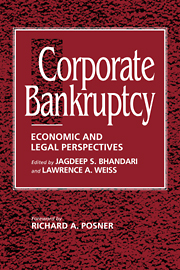Book contents
- Frontmatter
- Contents
- List of tables and figures
- Foreword by the HONORABLE RICHARD A. POSNER
- Preface
- Part I The role of credit
- Part II Bankruptcy as a reflection of the creditors' implicit bargain
- Part III Beyond the basic creditors' bargain
- Part IV Workouts or bargaining in the shadow of bankruptcy
- 19 Managing default: Some evidence on how firms choose between workouts and chapter 11
- 20 The economics of pre-packaged bankruptcy
- Part V Alternatives to bankruptcy and the creditors' bargain
- Part VI Experience of other countries
- Index
20 - The economics of pre-packaged bankruptcy
Published online by Cambridge University Press: 10 December 2009
- Frontmatter
- Contents
- List of tables and figures
- Foreword by the HONORABLE RICHARD A. POSNER
- Preface
- Part I The role of credit
- Part II Bankruptcy as a reflection of the creditors' implicit bargain
- Part III Beyond the basic creditors' bargain
- Part IV Workouts or bargaining in the shadow of bankruptcy
- 19 Managing default: Some evidence on how firms choose between workouts and chapter 11
- 20 The economics of pre-packaged bankruptcy
- Part V Alternatives to bankruptcy and the creditors' bargain
- Part VI Experience of other countries
- Index
Summary
A new kind of bankruptcy has emerged in the last few years. It can be thought of as a “hybrid” form – one that attempts to combine the advantages (and exclude the disadvantages) of the two customary methods of reorganizing troubled companies: workouts and bankruptcy.
In a workout, a debtor that has already violated its debt covenants (or is about to do so) negotiates a relaxation or restructuring of those covenants with its creditors. In many cases, the restructuring includes an exchange of old debt securities for a package of new claims that can include debt, equity, or cash. Informal reorganizations take place outside the court system, but typically involve corporate officers, lenders, lawyers, and investment bankers. And though such negotiations are often contentious and protracted, informal workouts are widely held to be less damaging, less expensive and, perhaps, less stressful than reorganizations under chapter 11.
Recently, however, a number of firms that have had most or all of the ingredients in place for a successful workout outside the courtroom have filed for bankruptcy anyway. In such cases, the distressed firms file a plan of reorganization along with their filing for bankruptcy. And largely because most creditors have agreed to the terms of the reorganization plan prior to the chapter 11 filing, the time (and presumably the money) actually spent in Chapter 11 has been significantly reduced.
The appearance of this new mechanism for corporate reorganization gives rise to a number of questions: How are they structured?
- Type
- Chapter
- Information
- Corporate BankruptcyEconomic and Legal Perspectives, pp. 322 - 326Publisher: Cambridge University PressPrint publication year: 1996
- 2
- Cited by



